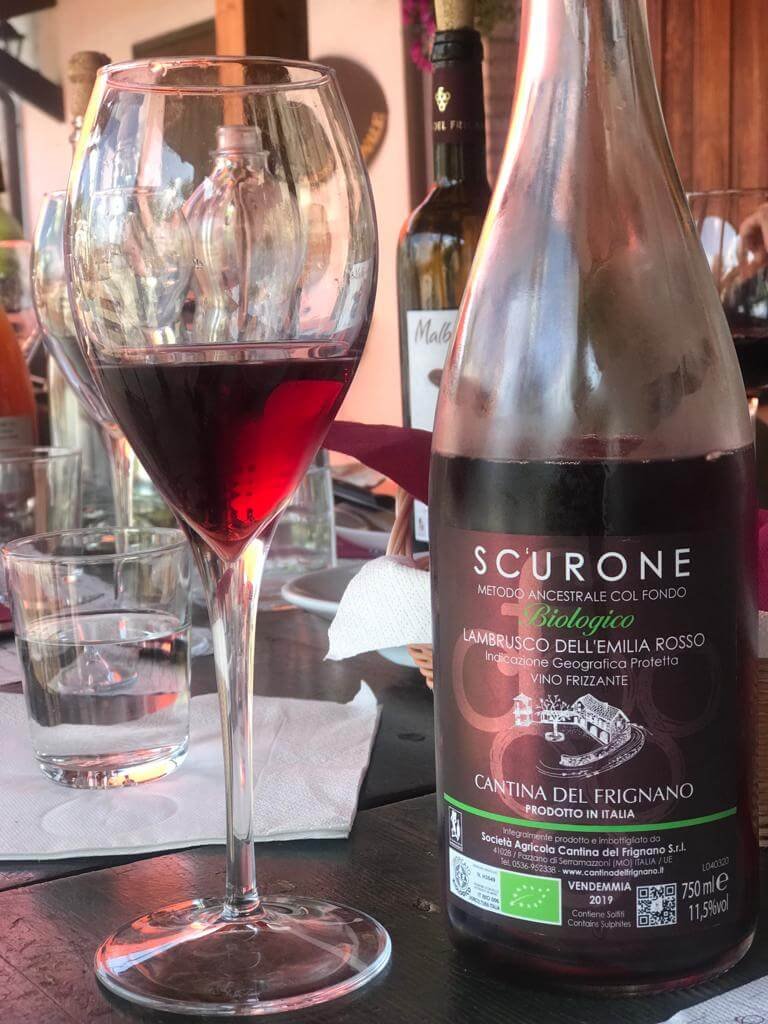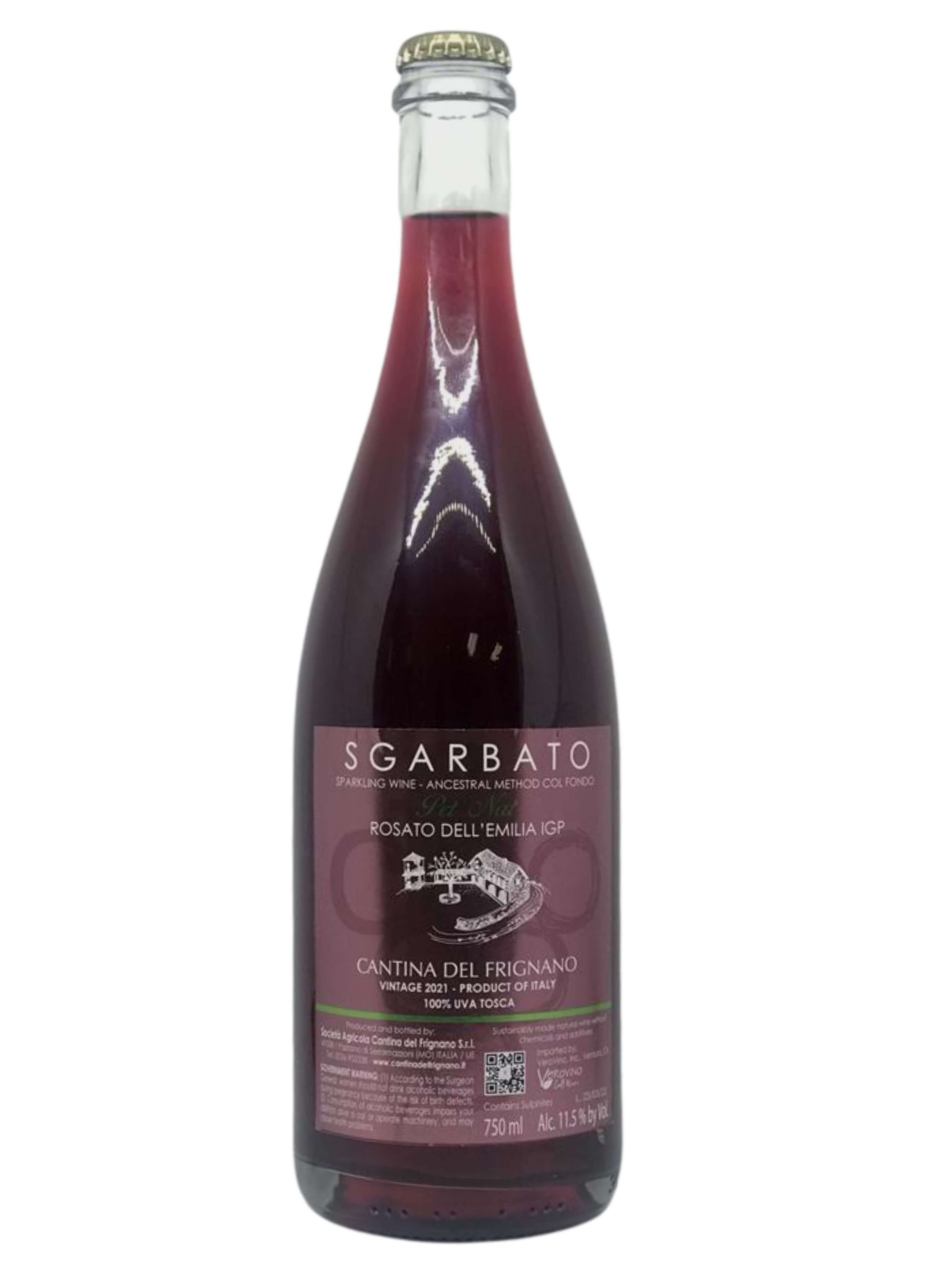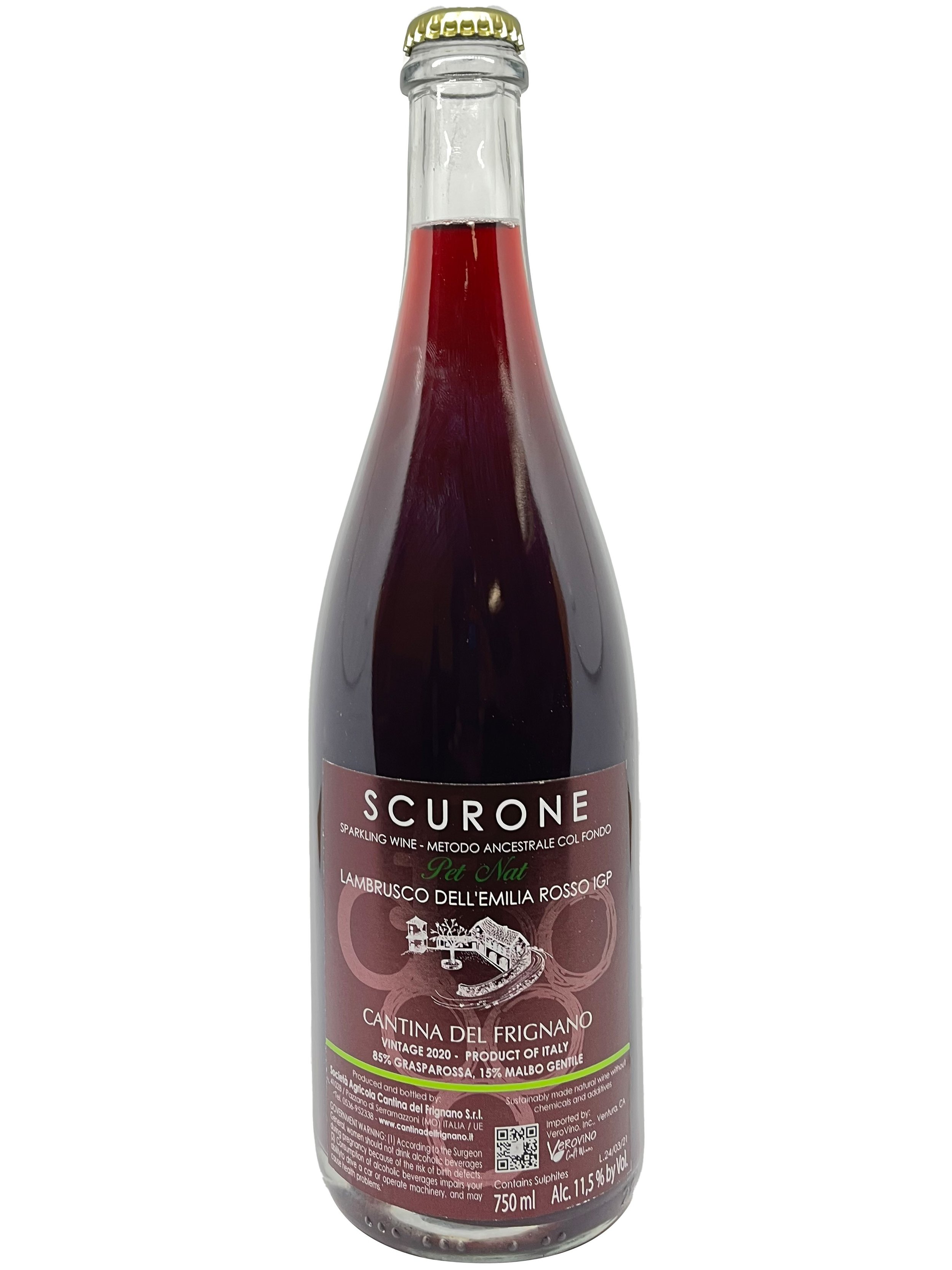Don't Say No to Lambrusco - The Fizzy Red Wine
This is a cluster of Lambrusco Salamino grapes at Bugno Martino about to be harvested. It’s called Salamino because the cluster looks like a salami.
Do you really know Lambrusco Red Wine?
Today's artisanal Lambrusco red sparkling wine made by youthful winemakers passionate for the grape bears little resemblance to the mass produced soda pop Lambruscos imported to the USA in the 1970s and 1980s. It was such a successful run that Lambrusco became the most imported wine in the 70s and 80s! For many years, even in Italy, Lambrusco was an industrially produced, simple, sparkling wine which tasted a lot like a sweet soda with alcohol. Often wines were pasteurized, and producers swapped the labor intensive classical method for charmat or tank method commonly used to make Prosecco sparkling Italian wine. This style of wine fell out of favor, and over 40% of Lambrusco vines were removed and replaced with other grapes or agricultural products between 2000 and 2010.
But today there’s an artisanal movement in Italy's Emilia-Romagna and Lombardy of Lambrusco made by a younger generation of producers like Vero's Frignano and Bugno Martino. These artisanal makers pay greater attention to the land and in the cellar only use natural fermentation. The resulting wines are really different than the Lambrusco of the 1970s and 1980s. Instead of being fruity, flabby, and syrupy, today's wines are vibrant, complex, dry, elegant, sparkling red wine Lambruscos that are made from one of the 60 or more varieties of the Lambrusco grape.
Lambrusco, a family of 17 grape varieties, with some saying over 60, are considered Italy's oldest grapes, going back to the Etruscans who were wine growers way before the Romans. One of the most autochthonous wines in the world (meaning native to the place where it is found), Lambrusco evolved to photosynthesize more efficiently and to combat the humid climate and powdery mildew by climbing trees.
Unlike other grapes, Lambrusco vines grow spontaneously from seeds. Most of the time if you want to grow a grapevine, you use a root stock to protect from the dreaded phylloxera, then you graft the type of grape you want onto that root stock. But with Lambrusco, you can actually start from the seed and get the vine you want, with no grafting required.
Lambrusco grows mostly in Italy's Emilia-Romagna (71%) region with only 9% of production grown in Lombardy, and the rest found in Puglia. The six most important grape varieties are:
Frignano’s Scurone Lambrusco made from Grasparossa.
1. Lambrusco Grasparossa
Grows best in hillsides with clay soils producing grapes with thick skins and dark fruit that evolve into structured wines that are earthy and tannic.
2. Lambrusco di Sorbara
Grows near Sorbara, a town north of Modena. This grape prefers sandy soils and produces grapes that make a more elegant wine that is pinkish in color, making it seem like a sparkling rosè wine. Dioecious, Lambrusco di Sorbara is female only so it needs to be planted with another Lambrusco to pollinate, often Salamino.
3. Lambrusco Salamino
The most abundantly planted of all Lambrusco, Salamino has a bit of everything, acidity, tannins and fruit. It is also often blended with its brethren.
4. Lambrusco Maestri
Its name derives from Villa Maestri in Parma, this is considered the softest Lambrusco identifiable by distinct bubble gum aromas.
5. Lambrusco Marani
A more rare variety to find, Marani is more delicate and lightly colored like Sorbara.
6. Lambrusco Viadanese:
Native to Mantua, in the Lombardy region just north of Emilia Romagna (where Bugno Martino estate winery is based), this is a flavorful Lambrusco typically made as a dry wine, with some semi-dry versions made.
Ready to say yes to an artisanal dry red sparkling Lambrusco?
As we mentioned above, Vero works with not one… but two special wineries that produce Lambrusco in Italy. One, Bugno Martino is located near Mantua in the Lombardy province. The other, Frignano is located in Emilia Romagna. Through both of these wineries we can cover two regions where Lambrusco can be found!
Raffaella and Giuseppe of Bugno Martino, enjoying a glass of Lambrusco in their Mantova, Italy vineyards.
Meet Bugno Martino
If yes, consider organic, natural Italian wine from grower-maker Bugno Martino who draws inspiration from how Lambrusco was grown and made in the olden days.
On a nine hectare vineyard, Bugno Martino owners, husband and wife Giuseppe and Raffaella Zavanella, grow four kinds of wine grapes. They live with their two children in San Benedetto Po near the Po River in the province of Mantua where they have a new tasting room where they pour their Lambrusco vino natural wines which they grow sustainably and are certified organic, which winery owners Giuseppe Zavanella and Raffaella Merlin call a “project of love first of all“. As Raffaella says “Giuseppe and I fell in love 20 years ago so this is a love story. We had our jobs in different branches (of wine). Giuseppe is deeply connected to sustainability for the environment. We studied a lot about wines particularly organic and natural wine making.”
When Giuseppe’s father Giovanni retired, “we discovered the old family farm was perfect for a winery to follow a natural and organic philosophy,” says Raffaella. Fifteen years ago they planted their first vineyard. Today nine hectares of Lambrusco are planted on their estate of 17 hectares. The rest of their farmland is used to grow grains, grass and flowers.
Various Lambrusco grapes can be blended to make artisan wine and these represent the future of vino Lambrusco, says Raffaella. “We are really proud the artisan Lambrusco is increasing day by day,” As these Lambrusco wines are really different from conventional wines, “we are very happy that they are really appreciated. Our mission is to return to Lambrusco its identity.”
The alluvial soil in their vineyards once was the Po river bed. “Our soil ranges from clay to less compact soils,” says Raffaella. This region is hot, humid, often foggy, which is why the vines originally climbed the trees to compete with mildew. The moisture makes the area a challenging environment to grow grapes naturally but they “do everything natural for the land, returning the organic material back to the soil,” according to Raffaella. They even have a meteorological sensor that analyzes the humidity of the climate in the vineyard so tells them how much copper and sulphur to use to combat the mildew so prevalent in the area.
Frignano owner, Irene Balim, inspects one of her Lambrusco vines on the estate.
Meet Frignano
Our second Lambrusco Italian winery, this one from Emilia Romagna is Frignano, run by woman in wine, Irene Balim. Originally from the Ukraine, Irene travelled to Italy, thinking to spend a year abroad, but she ended up falling in love with Italy and decided to stay. She found herself in the hills around Modena. That was 25 years ago, and she has never been happier than in her natural paradise. When her favorite local winery was going out of business. Irene just couldn’t let that happen, so she stepped in and took over the winery. Thus Frignano was born. There was a lot for her to learn, as she had farming experience from her grandparents and parents in Ukraine, but not in winemaking. But she learned fast and Irene has worked hard to prove her place, crafting fine wines and supporting the local area that she fell in love with so much she decided to move there. You can read Irene’s full story in our interview with her, or watch our video about Frignano on YouTube.
Looking at the wines Frignano makes, Irene has gone back to basics with her Lambrusco sparkling wine. Rather than follow the rest, she chose to do something different, making her lambruscos and sparkling wines using the ancestral method or as pet nat wine. You may remember that the ancestral method means the wines are fermented in the bottle, and aged on the lees in bottle. However, unlike other sparkling wines, they are not disgorged (or have the lees removed), so they go to market still aging on the lees.
Organic and natural, Irene’s wines are that perfect mix of different and unique that creates an unforgettable wine. From the rosé Sgarbato made with Uva Tosca that tastes like drinking a bright pink, tart cranberry juice, to the darker and richer Scurone Lambrusco made with grasparossa and malbo gentile, Irene’s wines let you know right away that these are not your ordinary Lambruscos.
Celebrate the summer with some delicious natural Lambruscos
A blend of Lambrusco Salamino and Ancelotta, this Lambrusco Mantovano DOP wine honors the famous medieval countess Matilde of Canossa who had a key role in the fight between the Papacy and the Empire around the 11th and 12th century by reclaiming the lands around San Benedetto Po. Matilde also helped get area vineyards growing.
Blending in Ancelotta grapes adds fruit and color to balance the freshness and earthiness of Lambrusco Salamino. This wine which is made using the Charmat method where a secondary fermentation takes place in a tank. It pairs great with pizza, as well as sausage based dishes (with having seven pigs per person in Mantua, what do you expect!)
This 100% Lambrusco Salamino wine is made in the ancestral method, how Lambrusco was made in the olden days, by continuing the fermentation in the bottle, aka pet nat style. It is not disgourged which means that the wine evolves over time with the lees in the bottle, aka col fondo. It has a complex savoury notes and flavors, liked to Umami, making it pair well with savory dishes, from Riso alla Pilota (a traditional dish from Mantua) to Asian food. The name references Bugno Martino's dedication to land, sun, time and work…the Essentials!
In Scurone Lambrusco, Irene plays with the blend of two in particular: Mostly lambrusco grasparossa and about 15% of malbo gentile. It is a fun blend that mixes the hyper-traditional (grasparossa) with the hyper-local (malbo gentile). But the blend has practical reasons too.
As mentioned above, lambrusco grasparossa makes deep colored wines, known for their body and tannins. Malbo gentile is similar, as it is also dark and tannic, but it has a fruitiness that softens the rough edges of the grasparossa, overall bring out in Scurone rich blackberry flavors. And all of this is balanced with grippier tannins than your normal Lambrusco, that mixed with bubbles gives fantastic sensations and texture with every sip.
Knowing, as well, that Irene at Frignano works with native yeast fermentation and that this wine has been fermented, aged, and bottled on those native yeasts, it is an amazing opportunity to taste a real local Lambrusco, as they used to make it. And, with a low alcohol around only 11.5%, it can make a great, interesting social sipper or even a wine to mix up your brunch or weeknight get together.
Bonus Lambrusco-Like Wine: Frignano Sgarbato Pet Nat Uva Tosca
While technically not a lambrusco wine, Frignano’s Sgarbato is very similar in style. Made in the same way as Scurone, just the grape changes to Uva Tosca. Nearly wiped out from phyloxxera and pressures to plant more economically viable lambrusco grapes, Irene of Frignano has made it her mission to help save this grape. Its sparse thick-skinned, greyish-red berries produce wines with a unique character. While mostly used in blends, taking a back seat as smaller percentages, it can also make a unique wine when used as a stand alone variety.
The frizzante Sgarbato is a delightful expression of the Uva Tosca grape in this pure form. While technically a rosé wine, it is more like a light red, which tastes like drinking cranberry juice as a sparkling wine. Refreshing and sippable there are strawberries on the nose to enjoy too, it is great on its own but it's also a great choice for a summer aperitivo.
Don't say no to Lambrusco! Say yes with Frignano and Bugno Martino
Ready to taste unique, hard to find, wild and scarce wines, like these Lambruscos? We're passionate about curating a selection of wines that is out of the ordinary conceptions of how these wines might historically have been like. As a wine merchant, we sell our portfolio of these authentic, wild and scarce farm-to-glass wines (and olive oils) to businesses and consumers across the US:
If you are a distributor reach out to us introduce our highly curated portfolio of one of a kind small production wines to your state.
We sell to wine stores and restaurants in certain states - contact us to learn more.
If our farm crafted wines and olive oils are not in your local shop or restaurant, buy wine online here, and we’ll ship it to you, including wine gifts.
We also have an award winning wine club for true wine explorers that are seeking to continually discover unique, sustainable and authentic small production wines they never had. These are wines selected by our sommeliers and curated for each box.
We do corporate gifts and sommelier guided wine tastings. Email us and we’ll tailor unique and sustainable corporate gift ideas.






